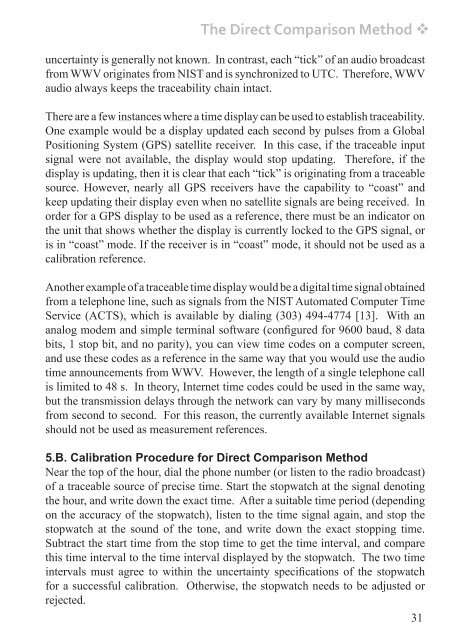Stopwatch and Timer Calibrations - National Institute of Standards ...
Stopwatch and Timer Calibrations - National Institute of Standards ...
Stopwatch and Timer Calibrations - National Institute of Standards ...
- No tags were found...
Create successful ePaper yourself
Turn your PDF publications into a flip-book with our unique Google optimized e-Paper software.
The Direct Comparison Method <br />
uncertainty is generally not known. In contrast, each “tick” <strong>of</strong> an audio broadcast<br />
from WWV originates from NIST <strong>and</strong> is synchronized to UTC. Therefore, WWV<br />
audio always keeps the traceability chain intact.<br />
There are a few instances where a time display can be used to establish traceability.<br />
One example would be a display updated each second by pulses from a Global<br />
Positioning System (GPS) satellite receiver. In this case, if the traceable input<br />
signal were not available, the display would stop updating. Therefore, if the<br />
display is updating, then it is clear that each “tick” is originating from a traceable<br />
source. However, nearly all GPS receivers have the capability to “coast” <strong>and</strong><br />
keep updating their display even when no satellite signals are being received. In<br />
order for a GPS display to be used as a reference, there must be an indicator on<br />
the unit that shows whether the display is currently locked to the GPS signal, or<br />
is in “coast” mode. If the receiver is in “coast” mode, it should not be used as a<br />
calibration reference.<br />
Another example <strong>of</strong> a traceable time display would be a digital time signal obtained<br />
from a telephone line, such as signals from the NIST Automated Computer Time<br />
Service (ACTS), which is available by dialing (303) 494-4774 [13]. With an<br />
analog modem <strong>and</strong> simple terminal s<strong>of</strong>tware (configured for 9600 baud, 8 data<br />
bits, 1 stop bit, <strong>and</strong> no parity), you can view time codes on a computer screen,<br />
<strong>and</strong> use these codes as a reference in the same way that you would use the audio<br />
time announcements from WWV. However, the length <strong>of</strong> a single telephone call<br />
is limited to 48 s. In theory, Internet time codes could be used in the same way,<br />
but the transmission delays through the network can vary by many milliseconds<br />
from second to second. For this reason, the currently available Internet signals<br />
should not be used as measurement references.<br />
5.B. Calibration Procedure for Direct Comparison Method<br />
Near the top <strong>of</strong> the hour, dial the phone number (or listen to the radio broadcast)<br />
<strong>of</strong> a traceable source <strong>of</strong> precise time. Start the stopwatch at the signal denoting<br />
the hour, <strong>and</strong> write down the exact time. After a suitable time period (depending<br />
on the accuracy <strong>of</strong> the stopwatch), listen to the time signal again, <strong>and</strong> stop the<br />
stopwatch at the sound <strong>of</strong> the tone, <strong>and</strong> write down the exact stopping time.<br />
Subtract the start time from the stop time to get the time interval, <strong>and</strong> compare<br />
this time interval to the time interval displayed by the stopwatch. The two time<br />
intervals must agree to within the uncertainty specifications <strong>of</strong> the stopwatch<br />
for a successful calibration. Otherwise, the stopwatch needs to be adjusted or<br />
rejected.<br />
31
















